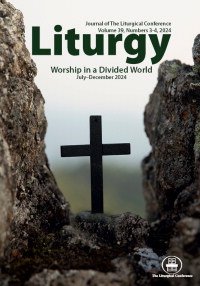In the Current Issue: "Food Allergies, the Body of Christ, and Liturgical Differences" (Part 1)
The issue of Liturgy entitled “Worship in a Divided World,” guest-edited by Benjamin Durheim, seeks to explore where our worshipping communities stand with regard to divisions that have pulled Christian worship patterns in divergent directions both negatively and, especially in recent times, positively as strengths. This excerpt is by Samantha Slaubaugh on navigating the needs of people with food allergies in worship and especially when serving the Lord’s Supper. The full essay is accessible through institutional and individual subscriptions. –– Melinda Quivik
~ ~ ~ ~ ~
As a child, I was formed by congregations that commonly practiced holding hands during the recitation of the Lord’s Prayer or Our Father. That embodied symbol—reaching out for the hand of a stranger—influenced my approach to liturgical practice and theological reflection for many years. However, when my first child was diagnosed with severe food allergies, suddenly the people I had hoped to reach out to, whether I knew them or not, became threats to my child’s safety. What had they eaten before coming here? Were their hands caked in the food proteins that could harm the life of my child? Interacting with strangers who did not know us, or my child’s invisible disability was cause of great anxiety for me as a parent. This new reality permeates every social and public gathering space. Even those who are aware of my child’s allergies can stoke my anxiety in their response to her needs. Living life alongside a severely food allergic child has revealed to me how truly intertwined we are with others; that interdependence is often not a source of theological hope or comfort, but rather the constant hum of anxiety and stress in the background of every interaction.
So, I come to the topic of “liturgy in a divided world” with mixed emotions about division. I have sometimes deliberately divided my child from her peers, denying her opportunities to build community, because I would be unable to keep her safe. Joining a community involves risk. Every time we eat food that we have not grown and prepared ourselves, she assumes the risk of cross-contact or faulty labels. Disability studies scholar, Michael Gill, who has food allergies, articulates the problem in this way: “Eating safely and following certain eating practices require diligence and not making assumptions that what was once safe to consume will be safe the next time. Or not assuming that as a consumer you can trust the countless employees in factories, kitchens, and production lines to follow protocol and industry practices and regulations. With each bite, a small risk comes along.” I call to mind not only food allergic people, but the many people who, because they diverge from what society has deemed “normal,” have found the church to be an unhospitable and even dangerous community. To navigate relationships in these churches may have posed physical, emotional, psychological, or spiritual risk of harm. When joining a community where one’s difference could be perceived at best as a distraction from what is “proper” or at worst as a threat to what is “good,” one’s safety might require division from that community.
As disability scholars have long suggested, society is an active participant in disabling others through its promotion of able-bodied norms, seen in its construction of spaces, practices, and legal regulations. While division can temporarily bring safety, separation from one’s oppressors or abusers does not bring justice. Justice cannot be found without safety, but safety can exist without justice, that is, without right-relationships. Thus, while keeping my child away from risky environments is appealing, division does not create a just world . . .
~ ~ ~ ~ ~
Samantha Slaubaugh is a Fellow at the Yale University Institute of Sacred Music. Her recent publications can be found here.
Samantha Slaubaugh, “Liberative Ingestion: Food Allergies, the Body of Christ, and Liturgical Differences,” Liturgy, 39, nos.3–4 (2024): 142–151, https://doi.org/10.1080/0458063X.2024.2369033.
